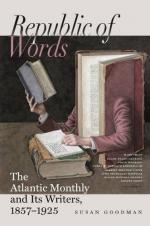The varied and wonderful shapes assumed by snow and ice have been best portrayed, perhaps, by Dr. Kane in his two works; but their resources of color have been so explored by no one as by this same favored Professor Tyndall, among his Alps. It appears that the tints which in temperate regions are seen feebly and occasionally, in hollows or angles of fresh drifts, become brilliant and constant above the line of perpetual snow, and the higher the altitude the more lustrous the display. When a staff was struck into the new-fallen drift, the hollow seemed instantly to fill with a soft blue liquid, while the snow adhering to the staff took a complementary color of pinkish yellow, and on moving it up and down it was hard to resist the impression that a pink flame was rising and sinking in the hole. The little natural furrows in the drifts appeared faintly blue, the ridges were gray, while the parts most exposed to view seemed least illuminated, and as if a light brown dust had been sprinkled over them. The fresher the snow, the more marked the colors, and it made no difference whether the sky were cloudless or foggy. Thus was every white peak decked upon its brow with this tiara of ineffable beauty.
The impression is very general that the average quantity of snow has greatly diminished in America; but it must be remembered that very severe storms occur only at considerable intervals, and the Puritans did not always, as boys fancy, step out of the upper windows upon the snow. In 1717, the ground was covered from ten to twenty feet, indeed; but during January, 1861, the snow was six feet on a level in many parts of Maine and New Hampshire, and was probably drifted three times that depth in particular spots. The greatest storm recorded in England, I believe, is that of 1814, in which for forty-eight hours the snow fell so furiously that drifts of sixteen, twenty, and even twenty-four feet were recorded in various places. An inch an hour is thought to be the average rate of deposit, though four inches are said to have fallen during the severe storm of January 3d, 1859. When thus intensified, the “beautiful meteor of the snow” begins to give a sensation of something formidable; and when the mercury suddenly falls meanwhile, and the wind rises, there are sometimes suggestions of such terror in a snowstorm as no summer thunders can rival. The brief and singular tempest of February




